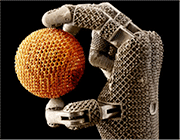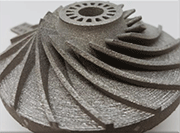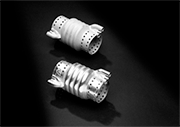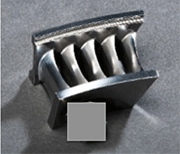E-Archive
Good Vibrations
in Vol. 19 - July Issue - Year 2018
Post Processing of 3D-Printed Components - A New Challenge For Mass Finishing And Shot Blasting

Photo 1: Artificial hand made with additive manufacturing

Photo 2: 3D printed part with support structure

Photo 3: 3D printed part with clearly visible rough surface

Photo 4: 3D printed heat exchanger

Chart 1: Heat exchanger surface roughness readings: (1) raw part, (2) after blasting, (3) after mass finishing

Photo 5: Blisk segment – raw part, Rz = 40 μ (1,600 micro inches). MBFZ toolcraft GmbH

Photo 6: Blisk segment – after finishing, Rz = 0.5 μ (20 micro inches) MBFZ toolcraft GmbH
No other technological development since the industrial revolution in the late 1800’s might transform industrial manufacturing more rapidly than additive manufacturing, generally known as 3D printing (photo 1). But post processing, i.e. removal of support structures and surface refinement, is posing significant technical challenges for the AM industry. Among all the surface preparation and finishing methods it appears as if mass finishing along with shot blasting will play a key role in the surface treatment of 3D-printed parts.
Additive manufacturing – the beginning of a new industrial revolution
3D printing is the process of making a physical object from a three-dimensional digital computer model by laying down many layers of a material in quick succession. This technology has been around for a while. But within the past 10 years it has literally exploded into the manufacturing environment in such diverse industries as aerospace, medical implants, electronics, jewelry, tool & die making and even automotive. Starting out as a rapid prototyping method AM is now on the verge of becoming a system for low-volume production of standard products.
The AM technology has evolved from desktop printers that melt a plastic material and lay it down onto a print platform to large industrial machines that use a laser to selectively melt and sinter powder at high temperatures. Today, components with dimensions of 1,000 x 1,000 x 500 mm and larger can be created from such diverse materials as plastic, all kinds of metal alloys and even zirconium ceramics.
Numerous technical and economic advantages
AM offers numerous benefits:
It is much faster than traditional production methods. Complex designs can be uploaded from a CAD model and physically created within a few hours compared to traditional prototyping that takes several days or even weeks.
AM is a single-stage manufacturing method. It eliminates various steps like cutting, bending, welding, machining, etc., and combines such activities into one single operation.
While traditional production methods like forging, casting, metal cutting or machining only offer a certain degree of freedom, AM is totally flexible and allows creating of the most complex parts. And above all, these designs can be easily customized. It allows, for example, the creation of medical implants like cranial plates for individual patients by creating a CAD model from a CT scan and sending this model to a 3D printer.
The costs of 3D-printed parts have come down drastically over the past 10 years. A work piece costing $50 – 60 a few years ago, can now be made for less than $10.
The post processing tasks
However, everything comes at a price. And before AM can fulfill the high expectations significant technical obstacles must be overcome! Post processing of 3D printed parts, specifically removal of support structures and surface finishing, poses entirely new challenges that – despite massive technical efforts -- have not yet been completely resolved.
Support removal: 3D printed parts are built layer by layer. Depending on the complexity of the design, the 3D print usually requires the simultaneous creation of more or less elaborate support structures (photo 2). These supports must be removed from the finished part, and the resulting blemishes in the form of surface roughness must be eliminated.
"Unpacking": This includes the separation of the component from the building platform, for example, by saw cutting, and the removal of loose and partially sintered powder residues from the part surface.
Surface smoothing: This may present the biggest challenge. 3D printing generally produces much rougher surfaces than traditional manufacturing methods. While Ra readings on castings, forgings, etc., are usually 3 – 8 μ (120 – 320 micro inches), the Ra values of 3D printed parts can be as high as 50 μ (2,000 micro inches), sometimes even higher (photo 3)!
Surface preparation for coating and painting: AM manufactured parts must frequently be coated or painted. Therefore, they must receive a homogeneous, textured finish. With traditionally produced parts this usually involves making a surface rougher. But because of the initially extremely rough surface of 3D printed parts, it must actually be made smoother, before it can be coated or painted.
Polishing: For functional or esthetic reasons 3D-printed parts, like any other components, frequently must be polished to Ra values of < 0.1 μ (4 micro inches). To go from around 50 μ (2,000 micro inches) down to 0.1 μ poses a serious challenge for any surface finishing technology!
Post processing with mass finishing and shot blasting methods
Many surface treatment methods like electrolytic deburring, chemical deburring, ultrasonic cleaning, laser cleaning, abrasive flow machining, etc., are being tried for 3D-printed parts. But it looks as if mass finishing and shot blasting will play a key role because of their uncomplicated operation allowing the simultaneous processing of multiple work pieces, their technical flexibility, cost efficiency and ease of automation.
Frequently, shot blasting and mass finishing complement each other, and this is especially true for 3D-printed parts, where shot blasting often precedes a subsequent deburring/smoothing/polishing process.
Shot blasting
This can include dry and wet blasting, dry ice blasting and even high pressure water jet blasting.
Shot blasting is ideal for unpacking and removal of loose and partially sintered powder from the part surface.
It is equally effective in creating homogeneous, textured surfaces as preparation for subsequent coating or painting. Sometimes, coatings are applied simultaneously with the 3D printing process. In such cases the work pieces must be carefully masked to prevent destroying the coated areas during the shot blast process.
While most of the time shot blasting generally makes metallic surfaces rougher, on account of the 3D printed parts having an initially very rough surface, shot blasting is frequently used for initial surface smoothing, the so-called "blast-smoothing", followed by mass finishing and sometimes, electro-polishing.
In the case of relatively thin support structures, which can be easily detached from the part, shot-blasting methods can be an option for support removal. Thicker supports must be removed either chemically (plastic), by heat, ultrasound, high-pressure systems, or mechanically (metal) by grinding them off.
Last-but-not-least, many 3D-printed metal parts must also be peened to improve their resistance against stress cracking and increase their fatigue life.
Mass finishing
The classical tasks for mass finishing are deburring/edge radiusing, surface smoothing and polishing.
Considering the initial high surface roughness values of up to Ra = 50 μ (2,000 micro inches), surface smoothing can be a daunting task, exacerbated by the fact that the finishing process must also be able to level so-called "stair steps" created by the 3D printing process.
The use of specially developed small but extremely abrasive grinding media and firmly fixturing the parts in the finishing machine will keep the required processing times at an acceptable level.
For smoothing/polishing tasks, special finishing methods like KeramoFinish® and Isotropic Super Finishing (ISF) systems are utilized.
Some examples:
Heat exchanger made from stainless steel (photo 4, chart 1)
- Initial surface roughness: Rz > 40 μ (1,600 micro inches)
- Combined shot blast / mass finishing process
- Surface roughness after shot blasting: Rz < 20 μ (800 micro inches)
- Surface roughness after mass finishing: RZ < 1 μ (40 micro inches)
Blisk segment made from Inconel (photos 5 and 6, before and after)
- Initial surface roughness: Rz = 40 μ (1,600 micro inches)
- Mass finishing process
- Surface roughness after mass finishing: RZ = 0.5 μ (20 micro inches)
The challenges ahead
No firmly defined post-process finishing methods have yet been established for 3D-printed parts, and a lot of development work lies ahead. This will require close cooperation between the manufacturers of 3D-printed parts and the surface treatment specialists. Especially, before a component design is finalized, it should be evaluated with regard to its post-process requirements. Here are some points that must be considered:
• In their component design, AM manufacturers may have to make allowances for the material removal from the part surface occurring with any mass finishing and shot blasting process.
• Most of the time 3D-printed parts are too delicate to tumble over each other but must be firmly fixtured in the shot blast or mass finishing machine to prevent part-on-part nicking. The AM manufacturers may have to foresee dedicated fixturing points in their component design.
• The AM manufacturers may have to "tweak" their designs somewhat to facilitate the removal of blast or mass finishing media from the work pieces and prevent media lodging. The designs should also allow for relatively easy access to internal passages for cleaning and smoothing.
• The biggest challenges no doubt are lying ahead in the effective and economical removal of the unloved but indispensable support structures. AM manufacturers are no doubt looking for partners that cannot only provide the desired surface finishes but are also able to remove the support structures, preferably in one integrated process!
Good Vibrations
by Eugen Holzknecht
Contributing Editor MFN and
Rösler Oberflächentechnik GmbH
E-mail: holzknecht.usa@gmail.com



























